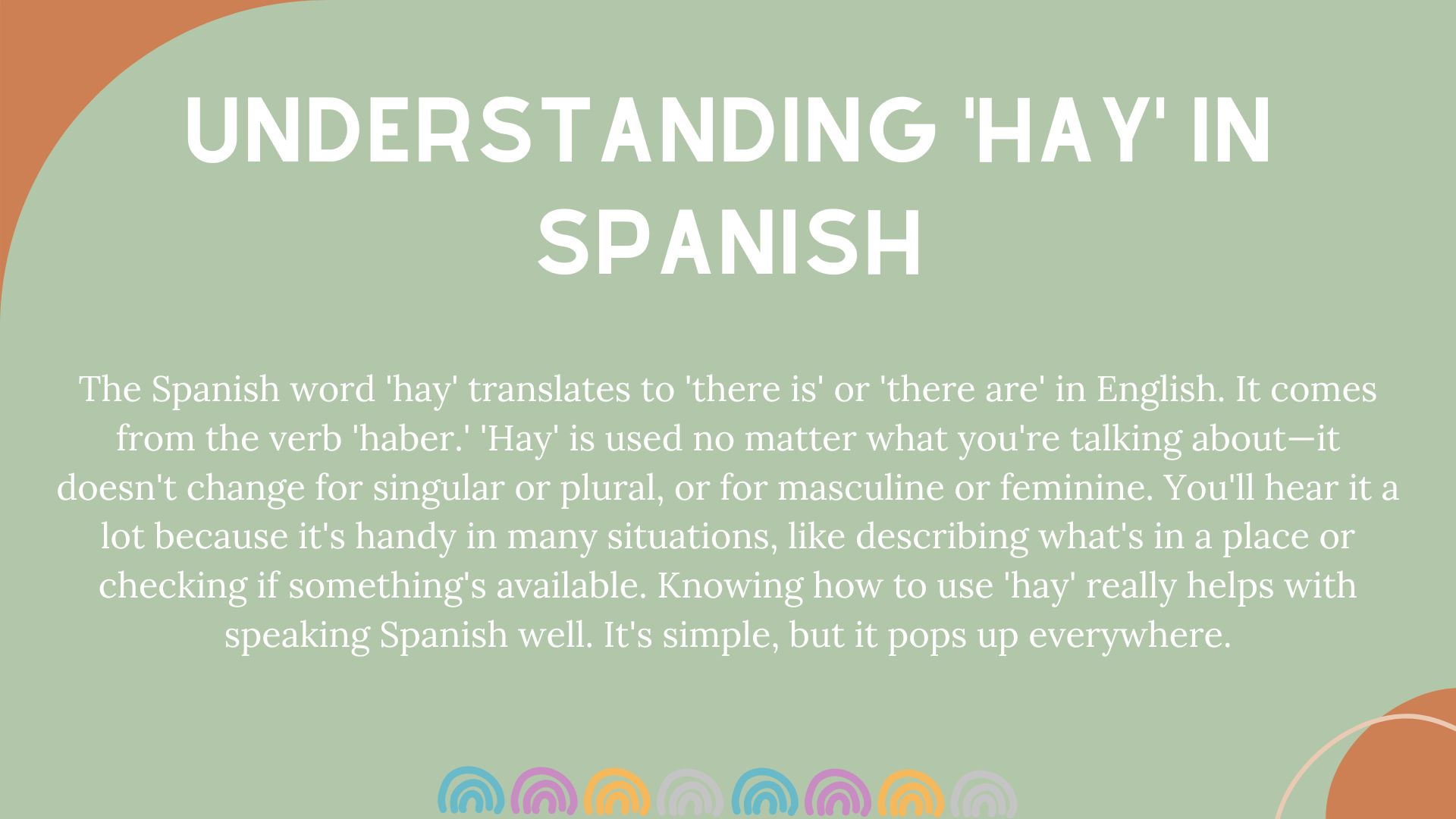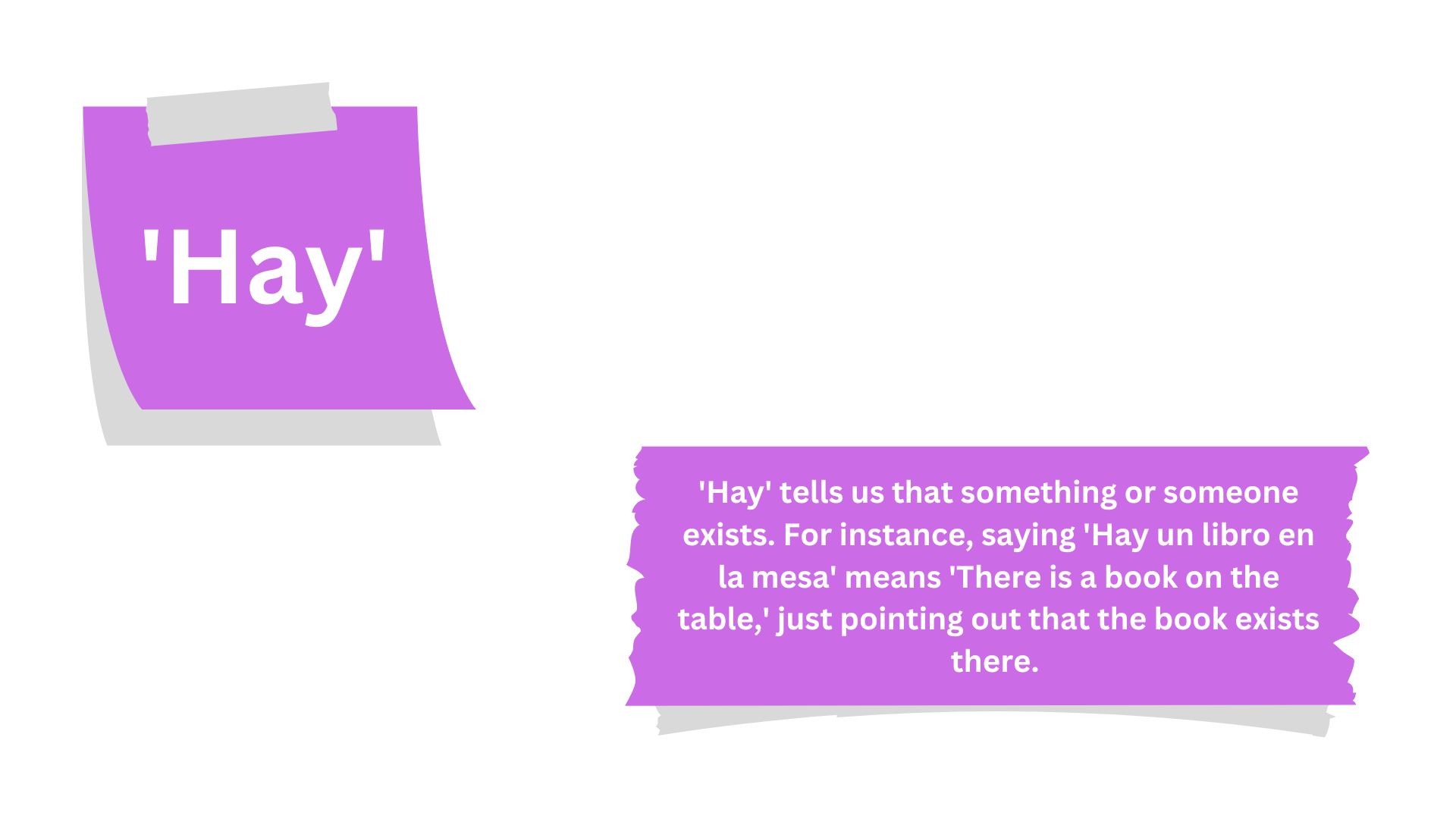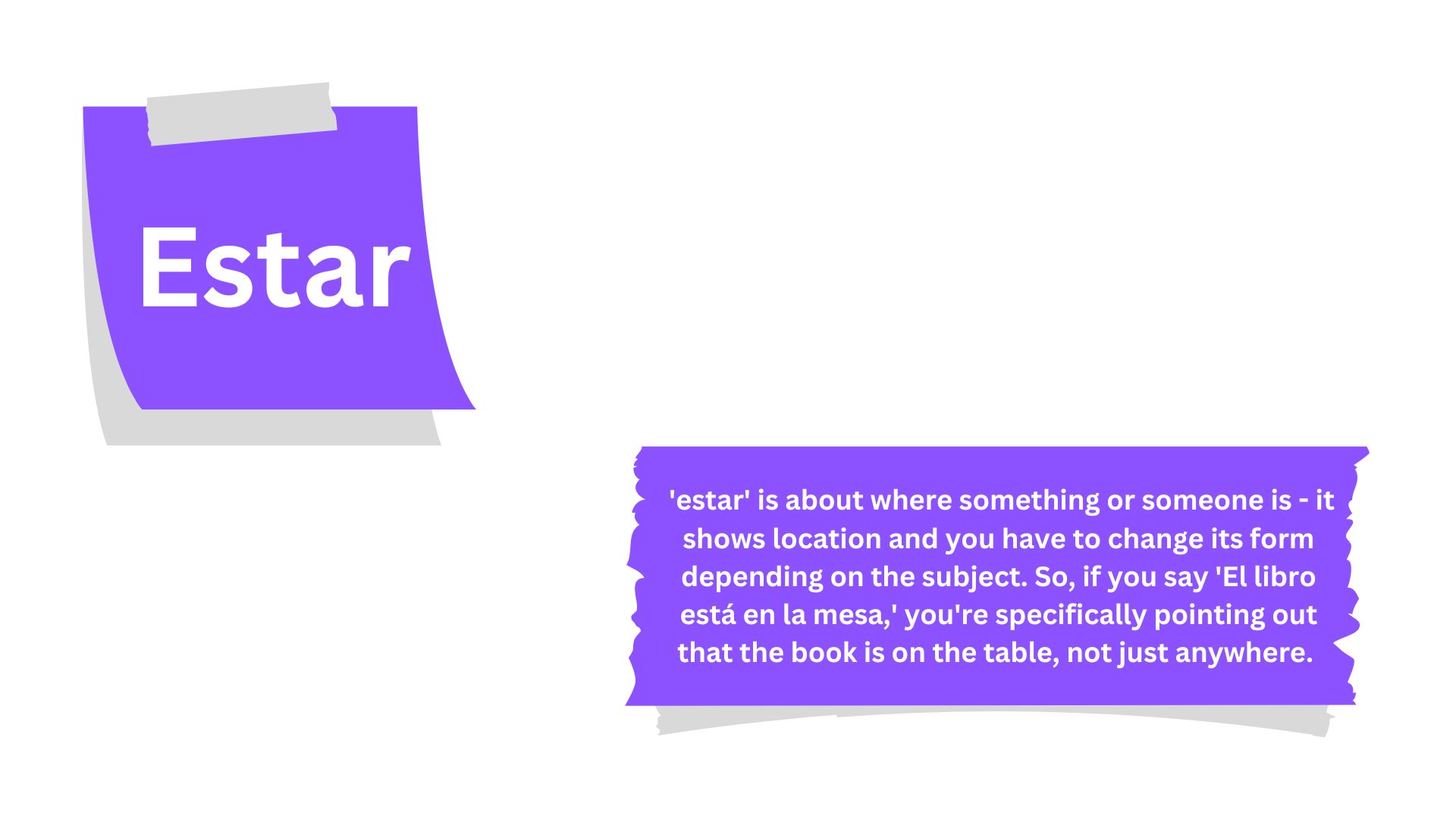When learning Spanish, the word ‘hay’ is crucial. It comes from the verb ‘haber’ and means ‘there is’ or ‘there are.’ It’s handy because it lets you talk about the presence of things or people without worrying about how many there are. You don’t need to mention where they are either.
Using ‘hay’ goes beyond just translating it from English. You need to know when and how to use it correctly. Understanding these differences makes you better at Spanish. It’s not just about grammar; it’s about making your communication clear and effective. So, as we dig deeper into ‘hay,’ we see how important it is.
Understanding ‘Hay’ in Spanish
Definition and Translation

The Spanish word ‘hay’ translates to ‘there is’ or ‘there are’ in English. It comes from the verb ‘haber.’ ‘Hay’ is used no matter what you’re talking about—it doesn’t change for singular or plural, or for masculine or feminine. You’ll hear it a lot because it’s handy in many situations, like describing what’s in a place or checking if something’s available. Knowing how to use ‘hay’ really helps with speaking Spanish well. It’s simple, but it pops up everywhere.
Usage of ‘Hay’ in Spanish
Singular and Plural Forms
One neat thing about the Spanish verb ‘hay’ is how it stays the same for both singular and plural items. This makes it really easy to use because you don’t need to change its form depending on how many things you’re talking about.
In lots of languages, verbs have to match whether they’re referring to one thing or many. But ‘hay,’ which comes from the verb ‘haber,’ simply means ‘there is’ or ‘there is , ‘no matter the number. This consistency makes it a breeze for anyone learning or using Spanish since you don’t have to worry about tweaking it for different situations.
Common Phrases and Examples
Exploring common phrases shows how ‘hay’ is a staple in everyday Spanish. The phrase ‘Hay que’ means ‘one must’ or ‘it’s necessary.’ For example, say ‘Hay que estudiar’ when you mean ‘One must study.’ In casual talk, ‘¿Qué hay de nuevo?’ is like saying ‘What’s new?’ or ‘What’s up?’ If something’s missing or doesn’t exist, we use ‘No hay,’ like in ‘No hay problema’ for ‘No problem.’ We also talk about the weather with ‘hay.’ Say ‘Hay sol’ for ‘It’s sunny’ and ‘Hay niebla’ if it’s foggy. These examples show how crucial ‘hay’ is in Spanish.
Also Read: Tu Vs. Usted In Spanish: Key Differences & Usage Guide
Differences Between ‘Hay’ and ‘Estar’
Contexts for Using ‘Hay’

When learning Spanish, it’s crucial to understand how ‘hay’ and ‘estar’ are used correctly. ‘Hay’ tells us that something or someone exists. For instance, saying ‘Hay un libro en la mesa’ means ‘There is a book on the table,’ just pointing out that the book exists there. Knowing when to use each word can really shape the way you speak and are understood in Spanish. It’s a simple but important part of mastering the language.
Contexts for Using ‘Estar’

‘estar’ is about where something or someone is – it shows the location, and you have to change its form depending on the subject. So, if you say ‘El libro está en la mesa,’ you’re specifically pointing out that the book is on the table, not just anywhere. Mixing up these verbs can make it unclear whether you’re talking about something’s existence or its exact spot. So, it’s a good trick to remember the difference to avoid confusion.
Also Read: Ultimate Spanish Adjectives Guide To Improve Your Vocabulary Skills
Words That Trigger the Use of Hay in Spanish
Certain words often hint that you should use hay in a sentence. While these words don’t always guarantee hay will be used, they often point to its presence when showing something exists.
Indefinite Articles
Words like un (a), una (one), unos (some), and unas (some) often pair with hay to show something exists.
Example: Hay un perro en el parque. (There’s a dog in the park.)
When they don’t trigger hay: Unos hombres están preguntando por ti. (Some men are asking for you.) The sentence has a subject, so hay isn’t used.
Plural Without an Article
When a plural noun appears without an article, hay shows the general existence of things.
Example: Hay libros en la mesa. (There are books on the table.)
When they don’t trigger hay: Vinieron personas de todo el mundo. (People from all around the world came.) The focus is on their action, not their existence.
Numbers
Use hay when stating how many of something exists.
Example: Hay tres perros en mi casa. (There are three dogs in my house.)
When they don’t trigger hay: Tengo dos gatos. (I have two cats.) This talks about ownership, not existence.
Uncountable Nouns
Words like agua (water), arroz (rice), and amor (love) often need hay to show existence.
Example: Hay agua en la nevera. (There’s water in the fridge.)
When they don’t trigger hay: Necesito arroz. (I need rice.) This expresses need, not existence.
Adjectives of Quantity
Words like mucho (a lot), poco (little), bastante (enough), and demasiado (too much) often go with hay to describe amounts.
Example: Hay mucha comida en la mesa. (There’s a lot of food on the table.)
When they don’t trigger hay: Tenemos mucho amor. (We have a lot of love.) This shows possession, not existence.
Conclusion
Understanding the use of ‘hay’ in Spanish is key to mastering the language. Knowing how to use ‘hay’ helps you talk about what exists, what’s there, and what’s available. It’s useful in daily chats and when you’re trying to paint a picture with words. Really, getting this verb down is crucial for speaking and understanding Spanish well.
As you keep learning Spanish, pay attention to how ‘hay’ works differently from other verbs like ‘estar’ and ‘ser.’ Practice regularly and use it in real situations. This will help you get really good at this important part of Spanish grammar. Keep at it, and use every resource you can to get better at using ‘hay’ wherever you can. Keep visiting the Translation Blog to learn different languages.

